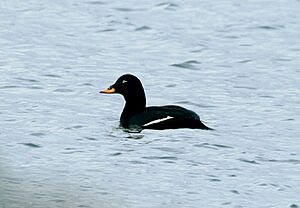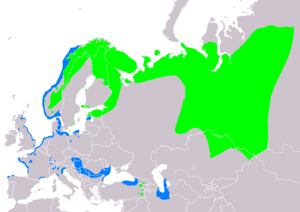Velvet scoter facts for kids
Quick facts for kids Velvet scoter |
|
|---|---|
 |
|
| Male | |
 |
|
| Female | |
| Conservation status | |
| Scientific classification | |
| Genus: |
Melanitta
|
| Species: |
fusca
|
 |
|
| Range of M. fusca Breeding Non-breeding | |
| Synonyms | |
|
Anas fusca Linnaeus, 1758 |
|
The velvet scoter (Melanitta fusca) is a large sea duck. It lives and breeds in the far north of Europe and parts of Asia. You can find it west of the Yenisey River.
The name Melanitta comes from two Ancient Greek words: melas meaning "black" and netta meaning "duck". The species name fusca comes from Latin and means "dusky brown".
Contents
About the Velvet Scoter's Name
The velvet scoter was first officially described in 1758. This was done by a Swedish scientist named Carl Linnaeus. He gave it the scientific name Anas fusca. Later, in 1822, it was moved to the genus Melanitta. This genus was created by a German zoologist named Friedrich Boie.
The velvet scoter is considered a single species. This means there are no different types or subspecies of it. It used to be thought of as the same as the white-winged scoter from North America. It was also once linked to Stejneger's scoter from eastern Siberia. But now, scientists know they are all different species.
What Does a Velvet Scoter Look Like?
The velvet scoter is a fairly big sea duck. It is about 51 to 56 centimeters (20 to 22 inches) long. Its wings can spread out 90 to 99 centimeters (35 to 39 inches). It has a thick neck, a wide bill, and a pointy tail.
Male velvet scoters are shiny black. They have large white patches on their wings. They also have small white spots behind their eyes. Their bill is partly orange. Female velvet scoters look similar to males. However, their feathers are not as shiny. They are also duller and more brownish.
Where Do Velvet Scoters Live?
These ducks breed in northern Europe. Their breeding areas stretch from Norway to the Yenisey River in central Siberia. They also breed in northeast Kazakhstan.
When winter comes, they fly south to warmer places. They spend winter in temperate areas. This includes parts of Europe, as far south as Great Britain. They also winter on the Black Sea and Caspian Sea. A few even reach France and northern Spain.
Velvet scoters often gather in large flocks on coastal waters. These groups are very close together. The birds usually fly off all at once.
Tabatskuri Lake in Georgia has the last breeding group of velvet scoters in the Caucasus region. Recent studies found only 25 to 35 pairs there. Not many of these pairs were nesting. Problems like finding nesting spots, gulls eating their young, and fishing activities made it hard for them to have babies.
Velvet Scoter Life Cycle and Habits
Nesting and Reproduction
Velvet scoters build their nests on the ground. They like to be close to the sea, lakes, or rivers. They often choose woodland or tundra areas. The female builds the nest. She hides it well in thick plants.
A female usually lays 7 to 9 creamy white eggs. Each egg is about 72 by 48 millimeters (2.8 by 1.9 inches). The female sits on the eggs for 27 to 28 days. She starts after the last egg is laid. She covers the eggs with soft down feathers when she leaves the nest.
The young ducks can feed themselves soon after hatching. They are cared for by the female. They become independent after 30 to 40 days. They are ready to breed for the first time when they are two years old.
What Do Velvet Scoters Eat?
These ducks find their food by diving underwater. They mostly eat crustaceans, like crabs, and molluscs, like clams and mussels.
Protecting the Velvet Scoter
The International Union for Conservation of Nature (IUCN) lists the velvet scoter as a Vulnerable species. This means it is at risk of becoming endangered. It is also one of the birds protected by the Agreement on the Conservation of African-Eurasian Migratory Waterbirds (AEWA). This agreement helps protect birds that travel long distances.




